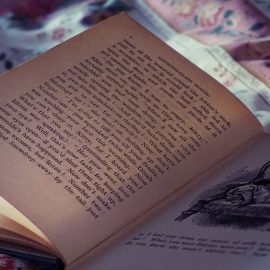

This article gives you a glimpse of what you can learn with Shortform. Shortform has the world’s best guides to 1000+ nonfiction books, plus other resources to help you accelerate your learning.
Want to learn faster and get smarter? Sign up for a free trial here .
Is the book really always better? What are some films and television adaptations that are actually an improvement from their books?
Making a book into a movie or TV show is one of the hardest tasks in filmmaking. Luckily, there are some cases where the adaptation actually turned out to be better than the original source material.
Read below for examples of movies and TV shows that tell the story better than the books.
Film Adaptations That Are Better Than the Book
Adapting books into films can be difficult, especially choosing information to keep or cut. Adaptations also have to replicate the tone of the original story. But sometimes, when given creative freedom, the directors and screenwriters are able to surpass expectations and create a story that is more enticing to watch than read. Here are the best examples of film adaptations made from books.
The Harry Potter Series
The Harry Potter books were a revolution in children’s storytelling, making the series one of the best-selling book series of all time. But the best thing that could’ve happened to Harry Potter was making the books into movies. While the eight movies left out a lot from their original source material, it was done so with respect and for the sake of storytelling.
For example, many people argue that The Goblet of Fire isn’t as good as the book of the same name because most of the story is cut in the movie. In order to get to a movie-length narrative, a lot of secondary storylines have to be cut because they don’t dramatically impact the primary story. By omitting key storylines such as S.P.E.W., The Goblet of Fire stayed focused on the Triwizard Tournament.
However, the main reason the adaptations are better is that you get to see the Wizarding World itself. While J.K. Rowling doesn’t spare any details about the world she’s created, it can be hard to imagine what it visually looks like. The movie makes the atmosphere and setting come to life—from the bustling Diagon Alley to the magical enchantments of Hogwarts. And a fun bonus: readers finally knew how to pronounce Hermione because most people didn’t know how when reading the books.
Little Women
Louisa May Alcott’s Little Women is one of the most adapted novels of all time, but Greta Gerwig’s interpretation of the novel is a near-perfect adaptation. In the 2019 film, Gerwig manages to stay faithful to the acclaimed novel while also tweaking it to respect Alcott’s original vision for the novel.
For example, in the book, Jo ends up marrying her boarding housemate Professor Bhaer and has children, despite saying she never wanted to do either of those things. In the film, Jo’s publisher proposes that the main character of her novel get married to sell well. Jo accepts this for a large percentage of the profits and copyright of the book. However, Jo stays unmarried and the final shot is of Jo looking happily at her published novel. It was a compromise for Jo. This was what Alcott apparently wanted for her heroine, but her publishers convinced her otherwise. In this way, Gerwig honors Alcott’s life.
Another big change for the better was the structure of the film. Alcott’s novel was originally published in two volumes in 1868 and 1869, with the first volume depicting the sisters’ childhood and the second volume depicting their adult lives. Gerwig’s version isn’t linear—it interweaves flashbacks with the present-day story to compare the two periods of their lives. In doing so, we see the struggles they face in adulthood compared to their carefree, happy lives in childhood.
No Country for Old Men
Cormac McCarthy’s No Country for Old Men can be difficult to read—especially for sticklers of grammar and punctuation. In quite an erratic fashion, many contractions are missing and apostrophes and quotation marks aren’t used. McCarthy’s writing is clipped, simple, and to the point. It might be because the novel was originally written as a screenplay, but nonetheless, some people weren’t happy about its style.
Underneath the seemingly intentional grammar mistakes was a great story that deserved to be told on screen. No Country for Old Men was always meant to be told in a visual medium and the Coen brothers’ 2007 film is a testament to that. The film is faithful to the novel and encapsulates McCarthy’s cool tone and simplistic dialogue. Watching the book come alive removes all the frustrations that come from grammatical errors, and makes it easier to enjoy the sinister story unfolding.
TV Show Adaptations That Are Better Than the Book
Sometimes, there’s too much ground to cover for a movie. This is where television comes in. For series with multiple books, a longer format is needed to do the story justice. In addition, some standalone books have a story so grand that it needs a miniseries to do the work. Let’s look at some TV series that make improvements on their source material.
The Walking Dead
AMC’s The Walking Dead is an adaptation of Robert Kirkman’s graphic novel series that ran from 2003-2019. But to say it’s faithful to the comics is an exaggeration. The television series has adapted concepts, characters, and ideas from the comics, but has drastically changed them for the better.
For example, the creation of key characters such as Daryl Dixon and sister-duo Lizzie and Mika gave the series some of its best storylines and saved the series overall. These characters weren’t in the comics, but 11 seasons into the show, Daryl is technically the protagonist and is considered a fan favorite. Lizzie and Mika’s psychologically thrilling storyline in Season 4 represented the scary reality of growing up as children in the apocalypse, which isn’t a huge storyline in the comics. Other key changes that made the series better are expanding or entirely changing storylines as a whole to better fit the television formula and raising the dramatization.
But by far the best change to the series is the overall graphic nature. The Walking Dead is still a gory horror drama at heart, but the comics are actually much worse. Difficult scenes in the comics include subjects of rape, sexism, and racism—and while the show does explore these topics, it’s done so with respect and precision, unlike the often tone-deaf comics.
Game of Thrones
Despite its controversial ending, Game of Thrones remains one of the most influential television shows of all time. This, in part, is thanks to the book series it’s based on: George R.R. Martin’s A Song of Ice and Fire. During the first five seasons of the television series, fans constantly compared the plot between the show and the book. Even when the show ran out of source material in Seasons 6-8, fans wondered how Martin would write the remaining books differently from the show.
A Song of Ice and Fire is an enthralling and captivating series on its own but compared to Game of Thrones, it’s a bit dense. The world-building in the novels can last for pages, exhausting the reader. The show benefits by just showing the world, rather than telling you.
In addition, both the book series and adaptation switch between characters’ stories constantly. One minute, you’re with Daenerys in Essos, and the next you’re with Jon Snow halfway across the world. The book does this by dedicating each long chapter to one character’s point of view, giving each character their own time to shine. However, if you’re not a fan of one character, it can pull you out of the experience and make it dreadful to continue. The show improves on this by using parallel editing and cutting scenes down, which gives the viewers just the right amount of time to stay with each character.
Little Fires Everywhere
Celeste Ng’s best-selling novel Little Fires Everywhere was adapted into a Hulu limited series starring Reese Witherspoon and Kerry Washington. Both the book and show follow two polar-opposite mothers, Elena and Mia, whose families become intertwined and their mysterious pasts are unveiled. But the biggest mystery of the series is who started the house fire that begins the story.
To say the limited series was an upgrade to the story is an understatement. The show remains faithful to the original source material for the most part, but significant changes made the story all the better. For one, the Hulu series adds a complicated layer to Elena and Mia’s conflict by specifying Mia and her daughter as Black. It’s a big change in the story, almost painting Elena as a villain because her judgments of Mia are implicitly motivated by racist stereotypes. But more importantly, it contributes to a conversation about race that is fundamentally missing in the book.
Another reason the show is better is how complicated Elena’s relationship with her youngest daughter Izzy is. In the book, Elena has a difficult relationship with Izzy because she can’t imagine her life without her, and loves her unconditionally. However, the series twists this narrative—Elena never wanted a fourth child (Izzy) and had to take time away from her journalism career because she had Izzy. This change makes the mother-daughter aspect of the story much more interesting and complex, seeing a mother who doesn’t have a lot of love for her daughter.
Your Favorite Adaptations
Do you agree that these adaptations were better than the books? Leave in the comments below, including your favorite book-to-screen adaptations that weren’t included on the list. In addition, check out our article on the biggest differences between Where the Crawdads Sing by Sally Rooney and its recent movie adaptation.

Want to fast-track your learning? With Shortform, you’ll gain insights you won't find anywhere else .
Here's what you’ll get when you sign up for Shortform :
- Complicated ideas explained in simple and concise ways
- Smart analysis that connects what you’re reading to other key concepts
- Writing with zero fluff because we know how important your time is






